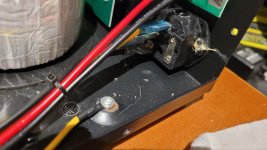G'day Guys,
A question regarding implementation of the chassis earth / protective earth (whatever one wants to call it)
I have previously used the implementation from Rod Eliots Site.

I was looking inside a PA amp recently and saw a slightly different approach of the screw going down into a tapped hole in the chassis rather than up into the chassis.

This approach perhaps makes more sense because as I understand it, legally the protective earth should be unable to be unscrewed from outside of the amp. With the approach provided by Rod one could plausibly unscrew it from the outside whereas this is basically implausibly with the PA amp approach.
So now comes the question:
Could this be more optimally done using a rivet nut?
Something like this

The advantage I can see is that one has much more thread area with a rivet nut that with a simple tapped thread through the sheet metal of the chassis.
Is it possible that the contact area with the rivet nut to the sheet metal is less than the contact area of a tapped hole?
For the record, the sheet metal that I am currently using is 2mm electrogalv steel.
A question regarding implementation of the chassis earth / protective earth (whatever one wants to call it)
I have previously used the implementation from Rod Eliots Site.
I was looking inside a PA amp recently and saw a slightly different approach of the screw going down into a tapped hole in the chassis rather than up into the chassis.

This approach perhaps makes more sense because as I understand it, legally the protective earth should be unable to be unscrewed from outside of the amp. With the approach provided by Rod one could plausibly unscrew it from the outside whereas this is basically implausibly with the PA amp approach.
So now comes the question:
Could this be more optimally done using a rivet nut?
Something like this
The advantage I can see is that one has much more thread area with a rivet nut that with a simple tapped thread through the sheet metal of the chassis.
Is it possible that the contact area with the rivet nut to the sheet metal is less than the contact area of a tapped hole?
For the record, the sheet metal that I am currently using is 2mm electrogalv steel.
And remember that if the case is multpart each part needs earth bonding to the others with the same rigour. Earth bonding should be tested at high current to ensure its robust in fault conditions. Anodized aluminium panels need scraping to bare metal, note, you shouldn't be relying on screw threads contacting the inside of the hole for your safety!
No, he could no way do it, if the additional locknut above the top nut was tightened properly.. . .
I have previously used the implementation from Rod Eliots Site.
View attachment 1161775
. . .
With the approach provided by Rod one could plausibly unscrew it from the outside . . .
If you just tighten the nut above all the washers, etc, and then you simply add the locknut and tighten again using a wrench and a screwdriver, or just a wrench, it may be still possible to unscrew from the outside with some/much effort.
But if you tighten the nut above the washers and then tighten nut and additional locknut using two wrenches, it is absolutely impossible to untighten the assembly unless you use two wrenches once more.
Just hold the nut stable with one wrench, and with the other wrench tighten the locknut against it, using A LITTLE force.
Too much, and you will be surprised how easily the screw will snap with no warning what so ever.
And remember that if the case is multpart each part needs earth bonding to the others with the same rigour. Earth bonding should be tested at high current to ensure its robust in fault conditions. Anodized aluminium panels need scraping to bare metal, note, you shouldn't be relying on screw threads contacting the inside of the hole for your safety!
Also true if you build a separate power supply with umbilical. The safety ground must run through the umbilical and also bond to the other chassis. When building any Amp I like to ask myself... Would I touch my Amp while standing on a damp concrete basement floor with wet feet and also while grabbing a nearby water faucet? If unconfident to do that then my Amp might be an electrocution hazard. I also like flange nuts for this bonding, they have more surface contact area as well as more bite as the bottoms are ridged to lock. Also m4 or better yet m5, m3 is too small to torque for this important connection.
More area = less contact pressure. You should be aiming for a cold-weld between the metal parts that's capable of handling high current transients without rising above milli-ohm levels of resistance. High contact pressure is necessary for that which is why anti-shake washers are really good. And definitely agree with M5 or larger.